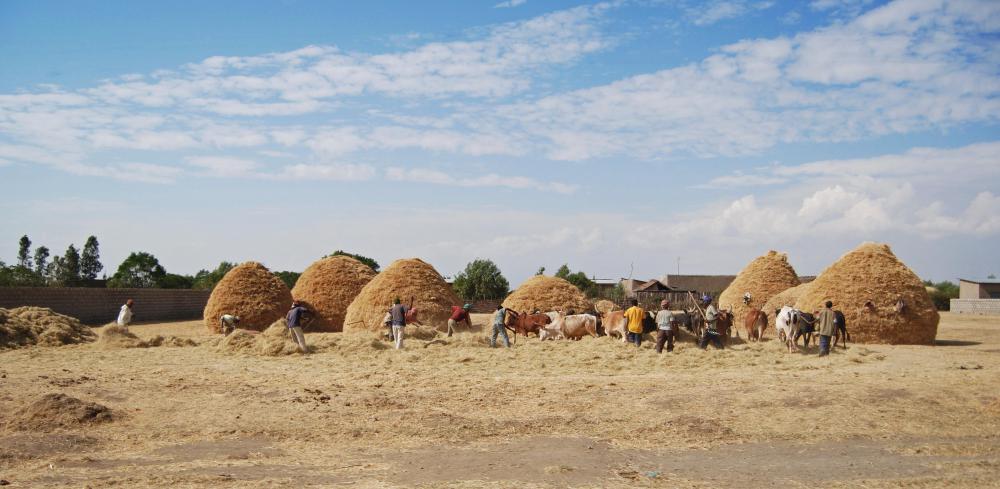At AllThingsNature, we're committed to delivering accurate, trustworthy information. Our expert-authored content is rigorously fact-checked and sourced from credible authorities. Discover how we uphold the highest standards in providing you with reliable knowledge.
What Is a Grevy's Zebra?
Grevy’s zebra is one of the three types of zebras. It is the largest and least sociable of the zebras. They are primarily found in northern Kenya and parts of Ethiopia, and are on the list of endangered animals.
The Grevy’s zebra appears to be more closely related to the wild ass than to the horse. Its large frame closely resembles that of a donkey. It has large, rounded ears and a narrow head. Characteristic black and white stripes run along its legs and body, though its stomach area is generally free from markings and is pure white. Its stripes are much narrower than on the other two species.

This zebra may grow to be as much as 9 feet (2.74 meters) long and 5.5 feet (1.68 meters) tall. The Grevy’s zebra can weigh nearly 1,000 pounds (453.59 kilograms). They are herbivorous animals and prefer a diet made up primarily of grass and plants. Grevy’s zebras generally only graze in close proximity to water sources.
While the mountain and plains species communicate with whinnying and snorting, this species makes more of a braying sound when it communicates with other zebras. While other zebra species lives in herds known as harams, the this species prefers to live alone or in very small groups. They only seem to gather into larger herds during the mating season. After a few months, the individual zebras stray off into smaller groups or individuals.
Male Grevy’s zebras are highly territorial. They will typically claim prime grazing areas and mark territory with piles of dung. Males will typically live alone or in small groups of two to six animals until the mating season, when the mares begin to move into the territory. The mating season of the Grevy’s zebra is generally from August to October. During this time, large herds may form.
The gestation period for the Grevy’s zebra is approximately 13 months, after which the mare generally gives birth to one foal. Twins are a rarity. After the mating season, the herd will slowly dwindle as the mares travel off with their foals. Young zebras may travel with their mother for as long as three years.
Predators and the loss of habitat to a growing society have put the Grevy’s zebra on the list of endangered species. Its habitat and food supply must be shared with growing herds of cattle, and its striking hide is highly prized by poachers. In an effort to save this zebra from total extinction, Grevy’s zebra researchers are working to gain a better knowledge and understanding of the animal and improve its chances for survival.
Frequently Asked Questions
What distinguishes a Grevy's zebra from other zebra species?
Grevy's zebras are the largest of all wild equids, easily distinguishable by their narrow stripes, white, bell-shaped underbellies, and large rounded ears. Unlike other zebra species, their stripes do not wrap around their belly. They also have a more donkey-like appearance and are less social than other zebras, often found alone or in small groups.
Where can you find Grevy's zebras in the wild?
Grevy's zebras are native to the Horn of Africa, primarily found in Northern Kenya with some small, isolated populations in Ethiopia. Their habitat ranges from semi-arid grasslands to open scrublands, where they have adapted to survive on less water and tougher forage than other zebra species.
What is the conservation status of the Grevy's zebra?
The Grevy's zebra is classified as endangered by the IUCN Red List. Their population has declined by more than 80% over the past three generations due to habitat loss, reduced access to water, poaching, and competition with livestock. Conservation efforts are ongoing to protect and stabilize the remaining population of around 2,800 individuals.
What do Grevy's zebras eat?
Grevy's zebras are herbivores that primarily graze on grasses, but they also eat leaves, bark, and fruit to supplement their diet. They are adapted to survive in harsh environments and can go for up to five days without water, obtaining moisture from the vegetation they consume.
How do Grevy's zebras socialize and reproduce?
Grevy's zebras have a unique social structure compared to other zebras. Males establish and defend territories to attract females, while females and their young move freely among territories. Breeding can occur year-round, with a single foal born after a gestation period of about 390 days. Foals are able to stand and run within an hour of birth.
What efforts are being made to conserve Grevy's zebras?
Conservation efforts for Grevy's zebras include habitat protection, anti-poaching measures, and community-based conservation programs. Organizations are working to secure and manage critical habitat, increase local awareness and engagement, and facilitate sustainable coexistence with livestock. These efforts aim to halt the decline of the species and ensure their survival for future generations.
AS FEATURED ON:
AS FEATURED ON:











Discussion Comments
Grevy's do seem to be more related to donkeys than to horses, especially given that they bray. I also understand that they can be very stubborn, which sounds more like a donkey.
Post your comments